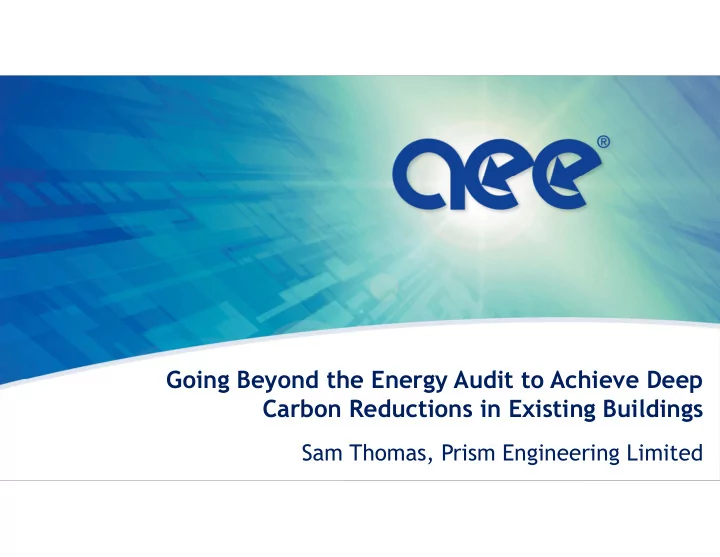

Going Beyond the Energy Audit to Achieve Deep Carbon Reductions in Existing Buildings Sam Thomas, Prism Engineering Limited
Agenda 1. Setting the context 2. Energy audits vs. deep carbon reduction studies 3. Practical challenges of deep carbon retrofits 4. Case study
Setting the Context
Shift in Priorities • Historically, commercial energy audits have been the cornerstone of energy reduction programs for existing buildings • Recently, the global importance of climate change has shifted the focus from strictly cost reduction to carbon reduction
Energy audits vs. deep carbon reduction studies
Energy Audit - Objective • The key objective of an Energy Audit is to identify, analyze, and present opportunities to reduce energy consumption and cost in a facility through reducing waste, improving efficiency, and (lastly) optimizing the supply of energy.
Deep Carbon Retrofit Study - Objective • The key objective of a Deep Carbon Retrofit Study (DCRS) is to identify available technologies, strategies and the investment required to reduce greenhouse gas emissions to meet specific carbon reduction targets.
Key Differences Energy Audit Deep Carbon Reduction Study Minimize waste x x Maximize efficiency x x No-cost / low-cost measures x Investment criteria ROI Environmental impact Investment outlook Short – Medium Long term Climate impact focus Low High Energy resiliency x Example measures Controls improvements Fuel switching Boiler upgrades Heat pumps VFDs on pumps, fans Co-generation Lighting retrofit Heat recovery chillers Heat recovery Envelope upgrades On-site generation Biomass boilers
DCRS Scope - Systems • Holistic review of entire facility and the interaction of its systems, including: • building envelope • HVAC • building automation • electrical systems (lighting, plug loads and elevators) • renewable energy systems
DCRS Scope - Modelling • A building energy model or simulation will often be required to account for the interaction of the building elements and their cross dependencies.
DCRS Scope - Recommendations • Unlike an Energy Audit, the presentation of recommendations in a DCRS is not based solely on ROI • Recommendations must be presented as business cases • Approaches include: • Bundling of high cost and low cost measures • Establishing an internal price on carbon • Leveraging non-energy benefits including: • Environmental impact • Equipment renewal • Leadership by example
DCRS Scope - Long Term Planning • View the integration of long-term capital upgrades to replace outdated equipment as an opportunity to consider low-carbon strategies as part of an equipment renewal plan. • Low-carbon strategies will be easier to justify when evaluating the option against the incremental cost over a “like for like” capital replacement.
DCRS Scope – Stakeholder Engagement • Buy-in and positive participation of all stakeholders is critical to the project success • Engage staff in the process (both study and implementation) and the importance of building operations and maintenance considerations • Conduct workshops to review priorities, and concepts with stakeholders on the feasibility of doing deep retrofits
Practical challenges of deep carbon retrofits
Practical challenges Technical • Carbon intensity of electricity grid • Possible electrical capacity constraints • Space to accommodate new systems (e.g. solar PV) • Major mechanical systems may need swing space • Architectural and heritage aspects of envelope renewal
Practical challenges People • Additional operator training requirements for more complex systems • Renovation impact on tenants • Expertise of contractors, consultants, operators
Practical challenges Financial • High cost upgrades • Discretionary spending may be challenging as we move out of COVID-19 • Seek out opportunities for incentives, rebates, and loans • Revise RFP/procurement evaluation to place larger emphasis on firms with experience in this area. (Lowest cost studies are not always the best!)
Case Study: Kitsilano Community Center (arena multiplex) • City of Vancouver • Base-case: • Oversized heating plant • Independent systems • Poor controls • Deep Carbon Retrofit • Right-size HVAC components • Integrate all systems • Heat recovery chillers for primary heating • Modified controls
Case Study
Case Study 40.00 2015 2019 35.00 30.00 GHG Emissions (tCO2e) 25.00 20.00 15.00 10.00 5.00 - Jan Feb Mar Apr May Jun Jul Aug Sep Oct Nov Dec
Closing remarks
Moving Forward • While the benefits of an energy audit should not be overlooked, a new ‘big picture’ approach is needed • Change in mindset needed by practitioners and building owners to look beyond energy cost savings • The engineering and construction sectors have a great responsibility and opportunity to reduce carbon output at a much more aggressive rate than generations past. Deep carbon retrofits in existing buildings are a large part of this future .
Thank you! Sam Thomas, BSc, CEM, CPEnMS(I) sam@prismengineering.com
Recommend
More recommend